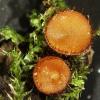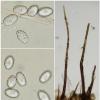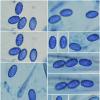
09-11-2025 13:20
Hello.A tiny ascomycete, appearing as erupting gra

08-11-2025 00:29
 Francois Guay
Francois Guay
I found this species in Quebec, Canada, on herbace

04-11-2025 09:07
Hello.A suspected Hymenoscyphus sprouting on a thi

04-11-2025 12:43
 Edvin Johannesen
Edvin Johannesen
Hi! One more found on old Populus tremula log in O

03-11-2025 21:34
 Edvin Johannesen
Edvin Johannesen
These tiny (0.4-0.5 mm diam.), whitish, short-stip
we collected this Scutellinia a few days ago on a log of Abies alba. A few key features: hairs long (partly > 1000 µm), base multifurcate; ascospores 18.8–19.9 x 11.6–12.1 µm (excluding ornamentation), surface with very irregular ornamentation, individual warts up to 3 µm wide, apparently not loosening when heated.
Thanks for your help and best wishes,
Gernot

The spore shape and ornamentation, combined with the ecology, go to S. cejpii.
Best wishes,
Gernot

The key of Kullman (1982) leads to Scutellinia scutellata var. macrosculpturata Kullman & Raitviir. It has long hairs, grows on wood and is "widespread" in what used to be the Soviet Union. The ornamentation of the spores is very coarsely verrucose, with confluent warts forming here an there an incomplete reticulum - I couldn't see that in your photographs, Gernot, but I won't exclude it either. Schumacher has placed the taxon into synonymy with S. colensoi, but using his key, the way is less straight than with Kullman.
Regards
Till
thank you for this valuable suggestion. I think the spores of my collection are somewhere between Schumacher's and Kullman's drawings: the ornamentation is a bit more dense and coarse than illustrated in the former (which is why I hadn't considered this species at first), and not quite as pseudo-reticulate as shown in the latter, although I do see some parts on my spores that could be interpreted as such. Overall it seems to me that for now Scutellinia colensoi/Scutellinia scutellata var. macrosculpturata are good working names for this collection.
Best wishes,
Gernot

good SEM illustrations of both colensoi and its extraeuropean relative, S. badioberbis, are also in Choi et al (2013): Scutellinia (Pezizales) in Korea, with a new species and eight new records. Nova Hedwigia 95(3-4): 457-476. I didn't see this species personally yet but according to Schumacher (1990), czech collections listed as badioberbis by Svrcek are most probably S. colensoi. Glejdura (2016) listed several collections from Slovakia where it seems to prefer similar old forests as S. pennsylvanica.
As for S. scutellata var. macrosculpturata, B. Kullman accepted the synonymy of her variety with S. colensoi in her more recent work: Bogacheva AV, Kullman B (2006): ???? ???? Scutellinia (Cooke) Lambotte (Pyronemataceae, Pezizales) ? ?????? [Species of the genus Scutellinia (Pyronemataceae, Pezizales) in Russia]. Mikologia i fitopatologia 40(3): 190-201. (only descriptions, without illustrations)
Best wishes,
Viktorie
Ok, I'll stick to unaccented ascii letters. Got it. (sigh)
thanks for this additional information. The present collection was also found in an old-growth Fagus/Abies forest. I would be interested in Glejdura (2016), do you have that as a PDF?
Best wishes,
Gernot

- S. peloponnesiaca he believes to be a good species, different from S. patagonica. Description based on 7 collections (from 3 localities): apothecia 0,5-3 mm diam. Marginal hairs 80-130(250) um long with simple to bifurcate base, lateral hairs differentiated only a little. Asci often with 4 developed and 4 abortive spores. Spores broadly ellipsoid, subglobose, rarely globose, 15-21,7 × 15-19,5 um. Ornamentation: unevenly distributed warts/tubercles, sometimes clustered to short irregular lines or small rings, 0,4-2,8 um wide and 0,4-1,4 um high. Growing on soil in broadleaved or mixed forests, collected in july and august, all localities are in coline level.
- He studied isotype of S. pseudoumbrarum in BRA and found no significant differences from S. umbrorum except for sightly narrower spores (Q = 1,5-1,58 for pseudoumbrarum vs. Q = 1,33-1,45 for S. umbrorum).
- There's a slovak collection of a scutellinoid fungus with white hymenium, reminding on S. nivea. This collection is according to SG conspecific with the Paratrichophaea chemnitzii Welt nom. prov. and he is convinced that this species + S. nivea would be better accomodated in a new genus.
- S. fujianensis (so far known from type locality in China) was found on 2 localities in Slovakia. Description: Apothecia 2-5 mm diam. Marginal hairs little differentiated, with 1-3furcate base, 130-540 um long. Lateral hairs up to 300 um long, 1-3furcate base. Spores ellipsoid to broadly ellipsoid, 15-18 × 9-11 um. Ornamentation consists of irregular warts, sometimes capitate, isolated, sometimes anastomosed with fine lines, 1,5-2,5 um wide and 2-3,8 um high.
- There are several slovak collections of S. trechispora with constantly bigger spores (20-22 um diam.) yet with standard 8spored asci; possibly new taxon.
Viktorie
I'd be interested in the Slovak article, too. Years ago I tried to pick up some Czech in order to read Dr Svrceks earlier texts - maybe it still helps ...
Regards
Till
Best wishes,
Gernot



